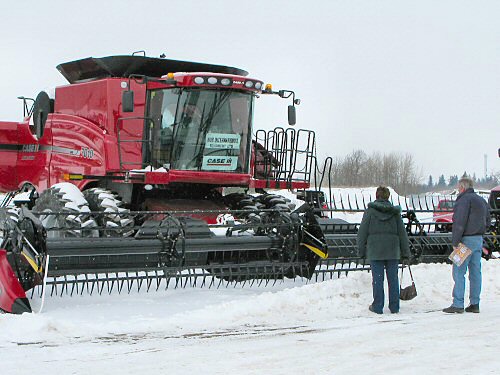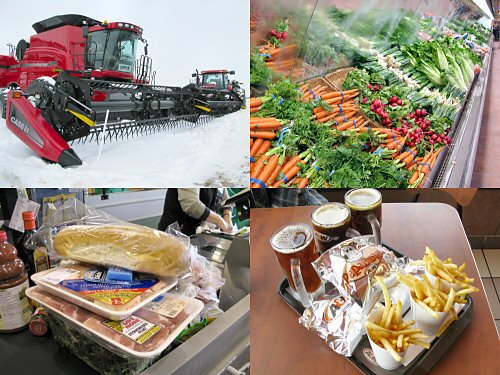
Took a trip to town today. During the winter, I get in once every 3-4 weeks, so it’s a bit of a novelty. This time in, we checked out an agricultural show, 28th year, filling the new fairground’s 45,000 sq ft of indoor exhibition space. It was quite busy, geared to the bigger conventional farmer, with aisles and aisles of heavy equipment, commercial seed, bank financing,… Outside, some even bigger machinery, like the combine harvester in the pic—it’s set up for soy—that could run over my entire garden in about 10 minutes (although the wraparound view from that air conditioned cab looks mighty inviting for a hot summer’s day in the field!). Inside, it’s mostly men in and around their 60s, with some wives scattered in. These guys were here with their fathers three decades ago, discussing new gear as family farms passed from fathers to sons. Now, the sons are the old farmers, and the next generation is nowhere in sight. Quite odd… Oh well, on to the super-sized supermarket, a Loblaws’ Wal-Mart killer, a huge deal with a produce court half the size of my market garden (not literally, but it’s pretty big), bakery, meat and fish counters, endless aisles, automated mini-bank, wine shop, tobacconist, full pharmacy, a whole section of clothing and housewares, and acres of convenient parking outside. It’s the old General Store, scaled up! I seldom do the grocery shopping for the farm, so when I do hit a supermarket, I head straight for the veggies first (I still kinda laugh at myself doing a “professional” veggie appraisal, this is the LAST situation I would’ve imagined myself in not too long ago). I bought some groceries: a bit of “fresh meat”, “fresh-baked bread”, a tub of mixed baby salad greens (and mine so soon to come!)… Only $200! Then, a quick fast food stop at A&W, not a guilty pleasure, or even a pleasure, just an old habit, a town routine… And there it was, a trip through the OTHER local food chain, 12 miles (19km) and a whole world away from the tiny farm. It’s a little surreal. Back to the seedlings… ;)





i never drink pop but man i totally want a root beer now!
This being the first comment that I am leaving on your blog, I would first like to thankyou for the time and dedication that you put into this. I have read every single entry, and enjoyed every minute of it. I look forward to each and every next post.
As I’m sure you’re curious about the types of readers who read your blog, I thought I would give you some of my background.
I’m a 21 year old farmer, and I’m in my 3rd year of a 4 year political science degree program. Sadly, I am only planning on hobby farming at the moment because I just couldn’t live off of the farm with prices right now. We sold our calves for 20% less than last year. If anyone is trying to imagine that in their heads, just picture you losing 20% of your wage out of the blue without your prior knowledge. For the American readers…. we just simply don’t have the subsidies and income supplement programs to the extent that the Farm Bill provides. I farm in between Janetville and Bethany, just east of highway 35 and just off of Fleetwood Rd. I’m sure you know the area. My family runs a 120 head cow-calf operation with 6 bulls and we rent 6 ranches in the summer to run them on. We usually run through 1000 4×5 hardcore round bales of hay every year, and maybe 120 rounds of straw. We market our cattle as stockers at around 500-700 pounds usually through Ontario Stockyards at Cookstown, and occasionally through the Kawartha Lakes Co-op sales barn in Woodville. In terms of ‘bad stuff’ that we pump into our herd: selenium and vitamin ADE at birth, penicillin if they are sick(and we wait the number of days required before shipping), Ivomec pour on solution to kill ringworm, worms, etc.(probably the worst thing we use) Prior to market, the stockers are also needled with Triangle 9 or an equivalent which is a vaccine against some things. That is a typical co-calf operator, but the feedlot operators may add more things as well. The hay that we use is usually only fertilized at planting with a mixture of nitrogen, phosporus, and potash. After that, they hay gets dusted with manure periodically, or is left alone. We don’t use any growth hormones, or anything else along those lines.
We also rent close to 1500 acres. We grow corn(which sometimes ends up at Mars Canada), soys, hard red spring wheat, hard red winter wheat, soft white winter wheat, soft red winter wheat(which usually ends up at Kraft), and oats(that usually end up at Quaker) Everything is on a grand scale, and done quickly and as efficiently as possible. Lots of big power! This is where some of those somewhat scary pesticides and herbicides are used, as well as the questionable genetically modified seed. However, conventional farmers are using Roundup(or an equivalent) which is glyphosate more and more often, and this herbicide is relatively safe. It immediately begins to break down once it comes into contact with the soil, so no washing, and no residual.
I’m also an active Junior Farmer and 4-H member. To get to the point, the Kawartha Junior Farmers are looking into establishing some sort of eat local campaign or program after looking into the 100 mile diet. We’re starting off by surveying the local grocery stores to see what sort of percentage of content of produce(including meats) are firstly from Ontario, and secondly local.
I happened to stumble across your farm website through the farmer’s market, and then found your blog.
Anyways, that ended up being rather long, but coming from my background, I think that some big-time conventional farmers fail to appreciate the merit and importance of eating local and farming organically. However, with society’s demand for cheap and abundant food, I don’t think organic farming will ever completely replace conventional farming in terms of the big food stuffs such as soys, wheat, and corn. The fact is that there are simply too many mouths to feed. However, there is a growing concern in society about the way in which our food is produced, meaning that the ever-growing market niche of organics is here to stay, and that conventional farming may have to step back and take a look what organic farmers are doing not only to satisfy consumer demands, but also to cut costs due to the rising cost of fertilizer.
I will probably write again once we have some more details on what we are up to in terms of this eat local stuff.
Wow Adam. No matter how much I pay attention to the state of local farming in the news, it always hits home to hear it from -excuse the expression – the horse’s mouth. Part of the reason I read TFB is because it gives me insight into the lives of the committed people who grow my own CSA order, and makes me that much more grateful for it. Thank you for adding more depth to this perspective. I will continue to advocate for local food, hoping that our local economy becomes more self-sustaining and supportive of our farmers.
Adam: Thanks for taking the time to describe your operation in detail. My 2-acre garden would be your farm gear parking lot! It’s hard to imagine two ways and scales of growing food existing in the same time and place. The people eating my veggies are also shopping for your stuff in the supermarket… I remember driving into the City four years ago to deliver 30 CSA shares, and passing a sign that said: “Welcome to Toronto, population 2 million” (or whatever the exact number was). What a schizo world! :)
I don’t know what will happen to big farming as oil peaks, and I agree with you that it’s hard to imagine feeding rich nations in the ways they’ve come to expect off of tiny farms… Cuba after the fall of the Soviet Union 1991 was interesting, they went from highly mechanized chemical agriculture and 60% of their food supply imported, to having nothing: no gas, no chemicals, no spare parts, no food imports, overnight. They managed to feed a country of 7 million by a form of aggressive organic ag, but that was top down, government decree, all university research focussed on new sustainable methods, sweeping changes to farming regulations… So it seems big farming can survive large-scale overhauls. In any case, our future’s not going to be dull!
Glad you’re enjoying the blog. I’m not exactly sure of why I’m doing it, but it’s fun!